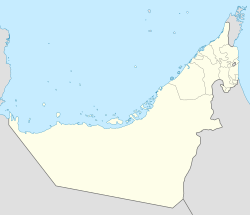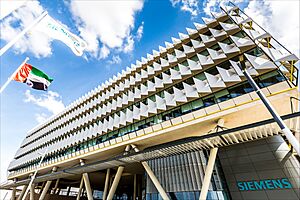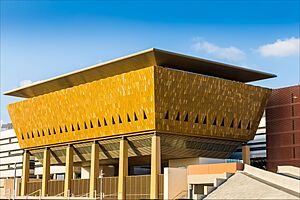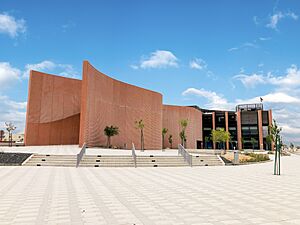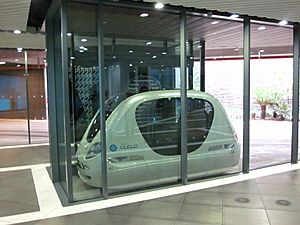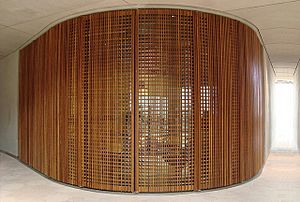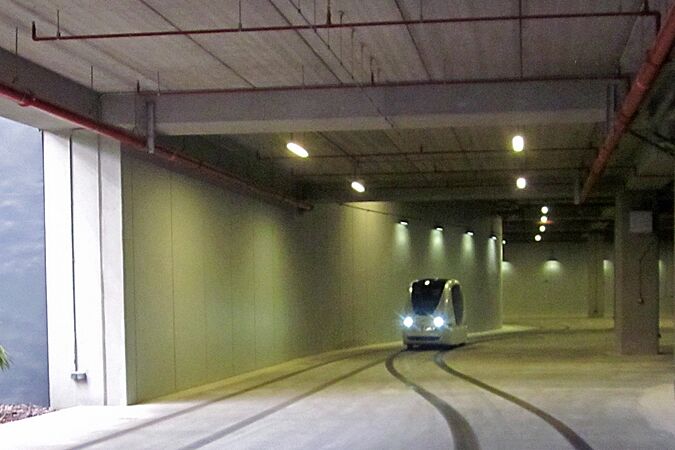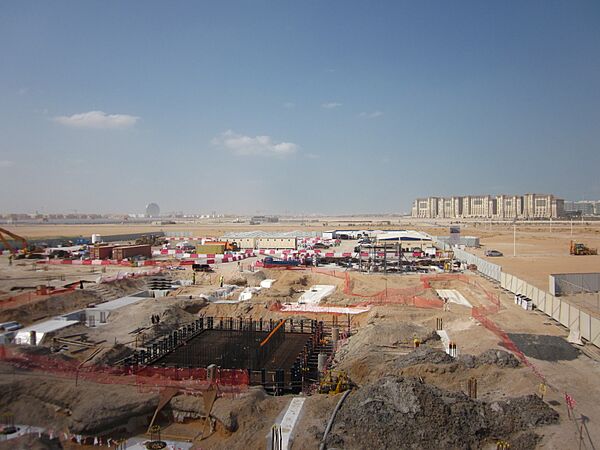Masdar City facts for kids
Quick facts for kids
Masdar City
مدينة مصدر
Masdar City Free Zone
|
||
|---|---|---|
|
UAE Free Zone
|
||
|
||
| Country | United Arab Emirates | |
| Emirate | Abu Dhabi | |
| Initiated | 2006 | |
| Area | ||
| • Total | 6 km2 (2 sq mi) | |
| • Land | 6 km2 (2 sq mi) | |
| • Water | 0 km2 (0 sq mi) | |
| Population
(2024)
|
||
| • Total | 15,000 | |
| • Density | 2,500/km2 (6,500/sq mi) | |
| Time zone | UTC+04 (Gulf Standard Time) | |
Masdar City (which means "Source City" in Arabic) is a special community in Abu Dhabi. Abu Dhabi is the capital city of the United Arab Emirates. This city was built by a company called Masdar. The government of Abu Dhabi provided most of the money to start it.
Masdar City was created to be a great example of sustainable living. It uses renewable energy, green building methods, and cool new technology. The city is designed to have a very small impact on the environment. Its buildings save energy, and it aims to reduce its carbon footprint. It also focuses on research into clean technologies. Many international companies, new businesses, and research groups work here. They all want to improve sustainable practices in different industries.
As of 2023, about 15,000 people live or work in Masdar City. The city is still growing a lot. Many new offices, labs, and homes are being built. These new buildings will help meet the demand for sustainable urban spaces. The city is expected to be fully finished by 2030.
Contents
What is Masdar City?
A Hub for Green Innovation
Masdar City is a special place for businesses. It is called a "Free Zone." This means companies here get certain benefits, like easier ways to do business. The city focuses on six main areas of industry.
- Smart Mobility (SAVI): This area works on electric and self-driving cars. It is led by the Smart and Autonomous Vehicles Industries (SAVI).
- Life Sciences: This includes studies in biotechnology, special medicines, and healthcare.
- Energy: Masdar City is a center for clean energy and new green technologies. Groups like IRENA and Siemens Energy are part of this.
- Agritech (AGWA): This area focuses on growing food in sustainable ways. It is led by the AgriFood Growth & Water Abundance (AGWA).
- AI: This cluster works on AI research and development. AI can help many industries, like smart cities and healthcare.
- Space Technology: This area supports new ideas in space. It includes the UAE Space Agency. They work on satellite technology and space exploration.
Working Together for the Future
Masdar City Free Zone has made important partnerships. These help businesses grow even more. For example, they work with Abu Dhabi Global Market (ADGM). This allows businesses to follow Common Law, which helps attract more foreign investment. They also partner with Amazon Web Services (AWS). This gives new companies access to cloud tools. Local banks also work with the Free Zone. They offer financial services for businesses there.
Companies and People in Masdar City
International Renewable Energy Agency (IRENA)
Masdar City is home to the International Renewable Energy Agency. This group is known as IRENA. It is the first international organization of its kind in the Middle East. Their main building was finished in 2015.
The UAE worked hard to bring IRENA's headquarters to Masdar City. They offered free offices and scholarships. They also offered loans for renewable energy projects in developing countries.
Masdar (Abu Dhabi Future Energy Company)
Masdar is the company that built Masdar City. It invests in many renewable energy projects. These include wind and solar power plants. It also develops sustainable real estate.
Siemens Energy
The main office for Siemens in this region is also in Masdar City. Their building is very special. It is a LEED Platinum building. This means it uses sustainable and energy-saving materials. It was designed to use 45% less energy. It also uses 50% less water than typical office buildings. The Siemens headquarters won awards in 2012. It was named the best and most sustainable office building.
Mohamed bin Zayed University of Artificial Intelligence (MBZUAI)
The MBZUAI is a university located in Masdar City. It focuses on teaching and research in AI.
G42
G42 is a company based in Masdar City. It specializes in artificial intelligence and cloud computing.
UAE Space Agency
The UAE Space Agency is located here. It helps support and guide the country's growing space industry. This agency is a key part of Masdar City's Space Tech cluster. This cluster includes groups working on satellites and space exploration.
The Catalyst
Masdar City and the oil company BP created "The Catalyst." This is an investor that helps new clean-tech companies. As of May 2023, The Catalyst supports eight new businesses. It wants to attract companies that focus on green technology. They welcome applications from businesses and entrepreneurs from all over the world.
Incubator Building
The Incubator Building was finished in 2012. It is the main office for Masdar City and its Free Zone. It has a central courtyard that helps keep the air cool. This encourages people to walk outside. The building's design helps reduce the need for cooling. Its slanted glass sides cut down on heat from the sun by over a third. Special porcelain circles filter direct sunlight. These circles have different colors to show how much sunlight they block. Horizontal shades also help balance light and reduce heat. These smart designs help cut energy use by 45%. The Incubator Building has shops and offices. It hosts new companies, small businesses, and regional offices for big companies. Some famous tenants included General Electric and Mitsubishi. It has a LEED Gold rating.
Khalifa University
A part of Khalifa University is in Masdar City. This used to be called the Masdar Institute of Science and Technology. The campus design is flexible. It uses old architectural ideas with modern materials. This helps save energy. By 2013, 336 students were studying there. These students were chosen from over 2,000 applicants. About 42% of the students were from the UAE. Also, 35% of the students were female.
The university's building was developed with the Massachusetts Institute of Technology. It uses 51% less electricity. It also uses 54% less drinking water than typical buildings in the UAE. A special system constantly checks how much power is being used.
How Masdar City Was Planned
The idea for Masdar City started in 2006. It was planned to cover six square kilometers. The cost was estimated to be around $18-22 billion. The original plan was to build it in about eight years. The first part was supposed to be ready by 2009.
Construction began in February 2008. The first six buildings were finished and used by October 2010. However, due to the Great Recession and the 2008 financial crisis, the completion date was pushed back. It was then expected to be finished between 2020 and 2025. By 2016, less than 300,000 square metres (0.12 sq mi) had been built. The final completion was then estimated for 2030. As of 2020, the 2030 completion date was still expected.
The city is meant to show how cities can be sustainable. It also aims to be a place for new ideas and community living. The design planned for 45,000 to 50,000 people to live there. It also expected 1,500 businesses. More than 60,000 workers were projected to travel to the city every day.
On June 24, 2022, Masdar City started building Masdar City Square. This new area will be 29,000 square meters. It will include a commercial building that produces as much energy as it uses. There will also be six other buildings with LEED Platinum and WELL Gold ratings. It is expected to be finished in 2024.
On February 2, 2023, Masdar City started building "The Link." This will be a mixed-use area of 30,000 square meters. It will have a "net-zero energy" building with offices and homes. There will also be four other LEED Platinum and WELL Gold buildings. These will include event spaces, fitness areas, and shops. It is expected to be finished in 2025.
Smart City Design
Masdar City is designed to be friendly for people walking and biking.
The streets in the city often feel 5-10 degrees Celsius cooler than the desert around it. This is because of the city's design. The main part of the city is raised higher than the surrounding area. It is also angled to pull wind through the streets. Buildings are built close together. This creates streets and walkways that are shaded from the sun. Also, a 45-metre-high (148 ft) wind tower helps. It is like old Arab designs. It pulls air from above and creates a cool breeze.
Masdar City has special homes called Eco-Residences. They have terracotta walls with beautiful patterns. They are rated LEED Platinum. The city also has a tech park. It is made from recycled shipping containers.
The design for Masdar City was created by Foster and Partners. Their team studied old cities like Cairo to see how they stayed cool. They found that these cities used shorter, narrower streets. These streets were usually no longer than 70 metres (230 ft). The buildings at the end of these streets created wind that pushed air upwards. This helped cool the streets.
Passive Design for Energy Saving
Masdar City uses smart design tricks to save energy.
- Building Shape and Orientation: Buildings are shaped and placed to get less direct sun. This means they absorb less heat. So, they need less air conditioning.
- Shading and Angling: Windows are placed to avoid direct sunlight, especially from the east and west. If direct sun cannot be avoided, special shades and angles are used. This helps reduce heat from the sun.
- High-Performance Building Envelopes: The outer walls of buildings are very well sealed and insulated. This keeps the inside temperature steady. It stops heat from getting in from outside. Materials that reflect sunlight are also used.
- Natural Ventilation: Buildings are designed so that fresh air can flow through them naturally. This reduces the need for air conditioning. It also makes the air inside healthier.
These smart design methods have saved a lot of energy in Masdar City. Some buildings use 50% or more less energy than regular buildings.
Getting Around Masdar City
You can get around Masdar City using public transport. There is also a special system called personal rapid transit (PRT). This system uses self-driving electric pods. They travel along an underground track.
In October 2010, it was decided that the PRT system would not be expanded much. This was because it was too expensive to build the underground tunnels. Later, in 2011, a test fleet of 10 Mitsubishi i-MiEV electric cars was used. This was a one-year test to see if they could provide point-to-point transport. They were meant to work with the PRT.
In 2018, a trial project started with seven self-driving shuttles called NAVYA. They carried passengers between the car park and the city center. Another route was planned for 2019. It would run from the residential area to the IRENA headquarters and a shopping mall.
Under a newer plan, public transport in the city will use other methods besides the PRT and NAVYA.
Masdar City is working on using a mix of electric and other clean-energy vehicles for transport. Most private cars will have to park in lots around the edge of the city. Abu Dhabi has a planned light rail and metro line. This might eventually connect Masdar City to the wider city area. As of 2020, connections outside the city are still mainly by car. The planned light rail line is not yet built.
Renewable Energy in Masdar City
The first plan for Masdar City was to have it run entirely on its own power. It was meant to have zero carbon emissions. Masdar City gets some power from solar panels. But it also gets power from the local electricity grid.
Gerard Evenden, the main architect, said that the first plan was to power the whole city with solar panels on rooftops. But then they realized it's much better to build a large solar farm in the desert. It's easier to clean the panels there. This way, they can make sure the panels work at their best.
Blowing sand has been a problem for the solar panels. So, Masdar City has worked with other groups. They are trying to create surfaces with tiny holes. These holes are smaller than sand particles. This stops sand from sticking to the panels.
The city uses special water fixtures that use less water. Wastewater is also reused "as many times as possible." For example, greywater (water from sinks and showers) is used to water plants.
The wood used on the outside of buildings is called palmwood. This is a sustainable wood. It comes from coconut palms that no longer produce fruit. Palmwood is used for things like entrance gates, screens, and doors.
What People Think About Masdar City
The project has support from groups like the World Wide Fund for Nature (WWF) and Bioregional. In 2008, WWF and Bioregional officially supported Masdar City. They liked its goals of zero carbon and zero waste.
The US Government has also supported the project. The US Department of Energy made a deal with Masdar. They agreed to share knowledge to help build zero-carbon cities.
The Alliance to Save Energy gave Masdar City an award in 2012. This was for its work in making energy use more efficient.
However, some people are doubtful. They worry that the city is just a symbol for Abu Dhabi. In 2011, Geoffrey M. Heal, an expert in environmental economics, called Masdar City "a gimmick." He said it was just a way to get attention. He also noted that its use of solar energy might not work everywhere. Few places have as much sunlight as the Persian Gulf.
Images for kids
See also
 In Spanish: Masdar para niños
In Spanish: Masdar para niños
- Abrahamic Family House, another international center in Abu Dhabi
- Sustainable city
- Sharjah Sustainable City



